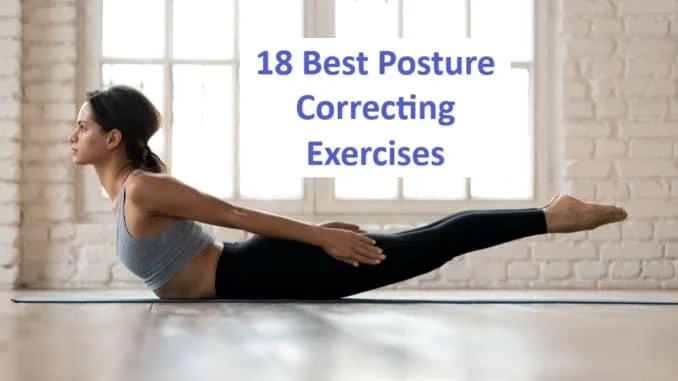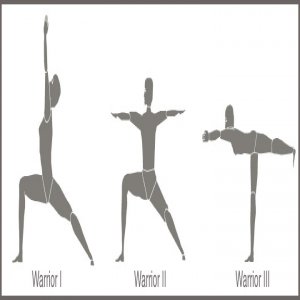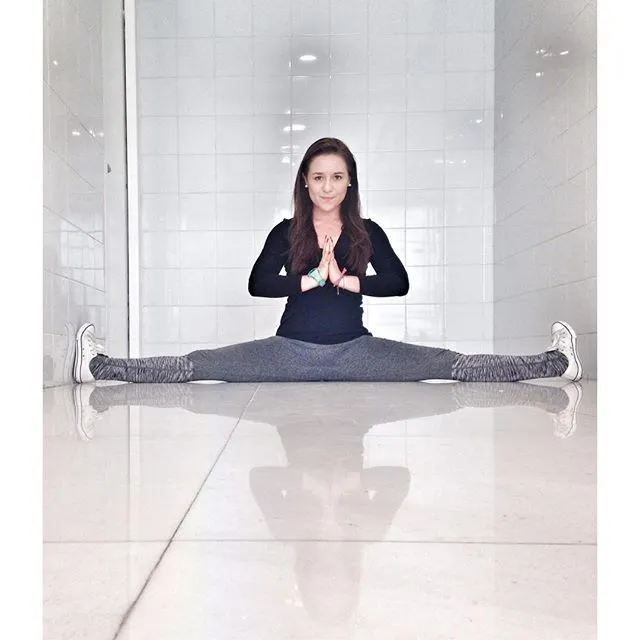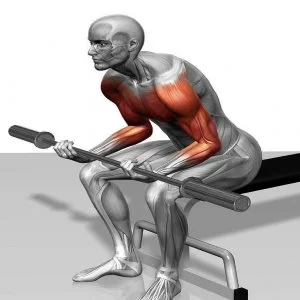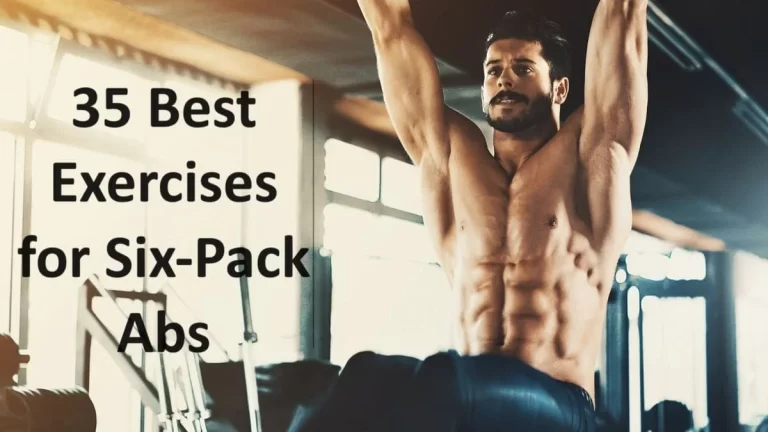18 Best Posture Correcting Exercises
Introduction
Posture-correcting exercises strengthen the muscles that support your spine and enhance your general posture.
Proper posture is necessary for preserving good health and preventing discomfort and harm. It can also support to enhance your appearance and morale.
In this speedy-moving life, we’re frequently staring at screens which not only impacts our eyes but also constantly leads to us having poor posture. And poor posture in itself can cause a lot of fitness problems such as headaches, neck and back pain, and even trouble breathing.
You may be capable of fixing or restoring your posture over the period with a mixture of yoga, stretching, and exercises scheduled to stretch and lengthen the spine.
Having proper posture is about more than just appearance. It aids in developing your body’s strength, flexibility, and balance. All of these can result in less muscular discomfort and increased energy throughout the day.
Proper posture can also lessen stress on your muscles and ligaments, lowering your chance of injury.
The upright posture can assist in increasing positive effects, decrease negative self-focus, and minimize tiredness in patients suffering from mild-to-moderate depression.
There are many different types of posture-correcting exercises, but some of the most common include:
- Wall slides
- Chest stretches
- Rowing exercises
- Planks
- Yoga
- Pilates
These workouts may be done at home or at a gym. It is important to choose exercises that are appropriate for your fitness level and to start slowly and gradually increase the intensity and duration of your workouts over time.
Correct Posture
The rules below outline proper posture when standing, sitting, and lying down.
Standing
- Standing with your feet facedown on the base, shoulder-width separated.
- Stand tall, as if a line is pulling upward from your head, and let your arms rest by your sides.
- Tighten your stomach and switch gently toward your spine.
- Hold your chin parallel to the floor.
Sitting at a desk or table
- Seat with your back straight and shoulders back.
- Keep your feet flat on the floor. avoid cross-leg seating.
- Relax your forearms on the flats while maintaining your shoulders back.
- Your chin should be similar to the floor, and your ears should align with your collarbone.
Lying down
- People can have correct posture while lying on their back or side.
- Make sure to maintain the spine straight and avoid twisting at the waist.
- Placing a pillow underneath or between the legs can help relieve back aches.
- Sleeping on one’s stomach should be avoided since it causes the neck to rotate, causing undue strain on the neck, shoulders, and back.
Common Cause for Poor Posture
There are many different causes of poor posture, but some of the most common include:
- Muscle weakness or imbalance: If certain muscle groups are weaker or tighter than others, it can lead to poor posture. For example, weak core muscles can cause you to slouch, while tight chest muscles can pull your shoulders forward.
- Sedentary lifestyle: People who spend a lot of time sitting or lying down are more likely to have poor posture. This is because the muscles that support good posture can weaken and atrophy from lack of use.
- Poor ergonomics: If you have a poorly designed workstation or use electronic devices in awkward positions, it can lead to poor posture. For example, hunching over a computer screen or texting on your phone can put strain on your neck and shoulders.
- Injuries: Injuries to the back, neck, or shoulders can also lead to poor posture. This is because the muscles that surround the injured area may tighten up or weaken in order to protect the injury.
- Medical conditions: Some medical conditions, such as scoliosis, kyphosis, and lordosis, can also cause poor posture. These conditions affect the alignment of the spine, which can lead to poor posture.
If you have poor posture, it is important to address the underlying cause in order to improve your posture and prevent long-term problems. For example, if you have weak core muscles, you can strengthen them with exercises such as planks and crunches.
If you have a sedentary lifestyle, you can become more active by walking, biking, or swimming regularly. And if you have poor ergonomics at work or home, you can make adjustments to your workstation or the way you use electronic devices.
Postural Disorders Which Caused by Poor Posture
Many people suffer from typical posture disorders, creating pain and possibly leading to health concerns. We have included a quick overview of 6 typical posture disorders in the short description.
1. Forward head posture
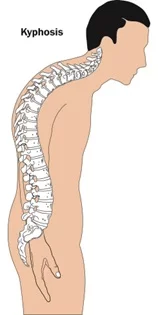
Forward head posture is a common type of poor posture. It occurs when the head is positioned too far forward in relation to the spine. This can put extra stress on the neck and back muscles and can lead to a variety of problems, including pain, stiffness, headaches, and dizziness.
Poor posture can be induced by a number of elements, including:
- Weak neck and upper back muscles
- Tight chest and shoulder muscles
- Injuries to the neck or back
- Specific medical disorders, such as arthritis & obesity
- Poor ergonomics
- Lack of physical activity
Forward head posture is often associated with poor posture because it can be caused by the same factors. For example, people who spend a lot of time sitting at a desk or using electronic devices are more likely to develop forward head posture.
This is because these activities can weaken the neck and upper back muscles, and tighten the chest and shoulder muscles.
2. Rounded Shoulder
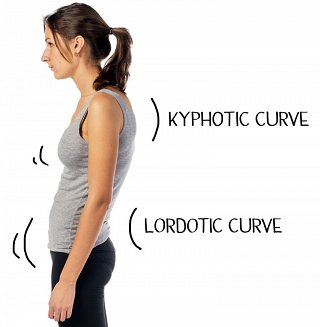
Rounded shoulders are a common type of poor posture in which the shoulders are rolled forward and the upper back is hunched. That can be induced by a combination of elements, including:
- Weak muscles in the back and shoulders
- Tight muscles in the chest
- Poor ergonomics
- Lack of physical activity
- Injuries to the neck or back
Rounded shoulders can put extra stress on the neck and back muscles, and can lead to a variety of problems, including:
- Ache and stiffness in the neck, shoulders, & back
- Headaches
- Neck and shoulder range of motion is reduced.
- Fatigue
- Poor circulation
3.Scoliosis
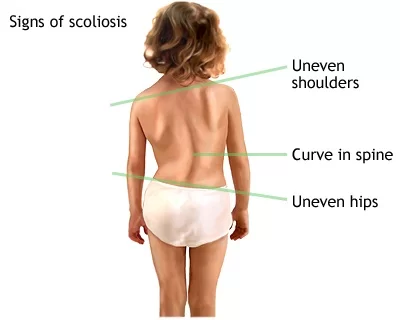
Scoliosis is a sideways curvature of the spine. It is a complex condition with many different causes.
Scoliosis is a structural abnormality of the spine, while poor posture is simply a habit of standing or sitting with incorrect alignment.
However, poor posture can make scoliosis worse. People with scoliosis often have asymmetrical muscles, which can lead to poor posture. This can put additional stress on the spine and make the curvature more pronounced.
If you have scoliosis, it is important to maintain good posture. This can assist in decreasing ache and enhance your general health and well-being.
4. Lordosis
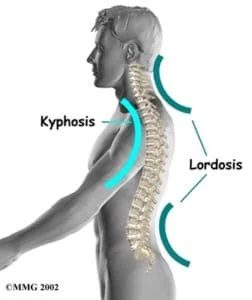
Lordosis is an exaggerated inward curve of the spine, often in the lower back. It is a type of poor posture that can be caused by a number of factors, including:
- Weak abdominal muscles
- Tight hamstring muscles
- Obesity
- Pregnancy
- Certain medical conditions, such as arthritis and spina bifida
Poor posture can also lead to lordosis over time. For example, if you slouch when you sit or stand, your lower back will curve inward more than it should. This can put extra stress on the spine and lead to lordosis.
Lordosis can cause a variety of problems, including:
- Pain and stiffness in the lower back
- Hip pain
- Knee pain
- Reduced range of motion in the back and hips
- Muscle spasms
- Fatigue
5. Flatback
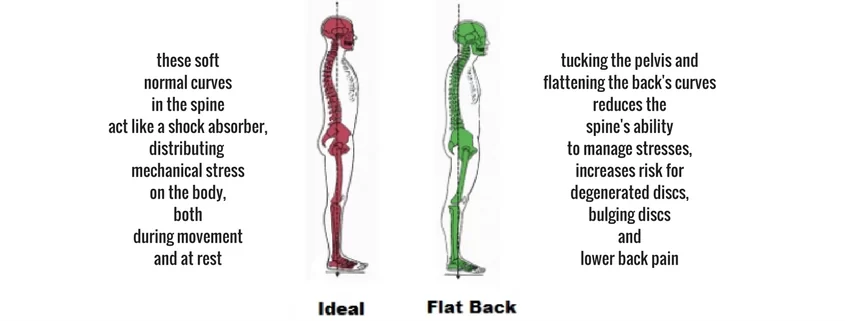
A flat back is a type of poor posture in which the natural curvature of the spine is reduced or absent. This can be generated by a number of elements, including:
- Weak abdominal and back muscles
- Tight hip flexor muscles
- Poor ergonomics
- Lack of physical activity
- Arthritis and osteoporosis are two examples of medical problems.
A flat back can put extra stress on the spine and lead to a variety of problems, including:
- Ache and stiffness in the back, neck, & shoulders
- Muscle spasms
- Decreased range of motion in the spine
- Headaches
- Fatigue
6. Uneven Hips
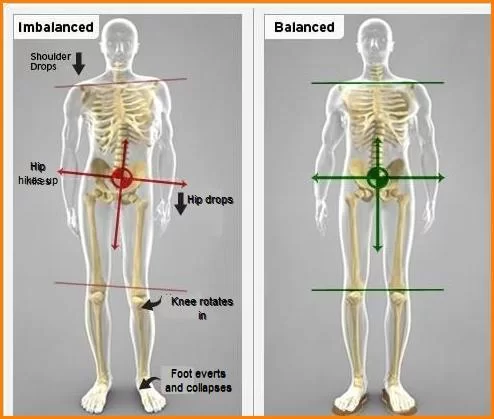
Poor posture can make uneven hips worse. When you have poor posture, your body will compensate by shifting your weight to one side. This can put extra stress on your spine and pelvis and can lead to uneven hips.
Uneven hips can be caused by a number of factors, including:
- Leg length discrepancy
- Scoliosis
- Functional leg length discrepancy (FLTD)
- Poor posture
Best Posture Correction Exercises Video
Best Posture Correction Exercises
Shoulder Blade Squeeze
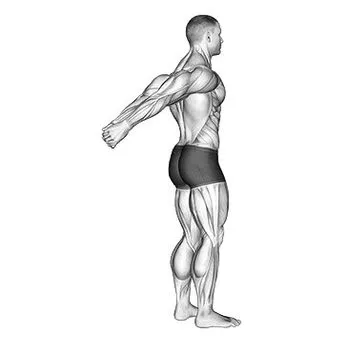
The shoulder edge squeeze is an easy exercise that can assist in enhancing posture correcting by strengthening the muscles in the upper back and shoulders.
This exercise concerns pressing the shoulder blades jointly and maintaining the position for a few moments before releasing. It’s a great workout for Posture Correction who spend a lot of time sitting or working in front of a computer.
Here’s a step to doing the shoulder blade squeeze exercise:
- Start by sitting or standing with your back straight & your arms by your sides.
- Gently draw your shoulder edges back and down, pressing them together.
- Maintain this position for 5-10 seconds, keeping your back straight and your shoulders relaxed.
- Relieve the contraction and allow your shoulders to rest back to their starting position.
- Repeat this exercise for 2-3 sets of 10-15 repeats, taking a brief pause between every set.
- Precautions: Instead of tensing your neck or hunching your shoulders, concentrate on pressing your shoulder blades together.
Chin Tuck

The chin tuck is an easy Posture Correction exercise that can assist in correct posture and relieve neck pain.
This exercise includes gradually tucking the chin in towards the neck, which can assist in improving head and neck alignment.
It’s an excellent workout for anyone who spends a lot of time staring at a computer or phone screen.
Follow the steps below to do a chin tuck exercise:
- To begin, sit or stand with your back straight and shoulders relaxed.
- Consider a thread attached to the top of your head and slowly pulling your head higher.
- Tuck your chin slowly towards your neck, maintaining your gaze straight ahead.
- Hold for 5-10 seconds, while experiencing a mild stretch at the base of your neck.
- Return your head to its initial position after releasing the tuck.
- Repeat this exercise for 2-3 sets of 10-15 repetitions, with a short rest in between.
- Precautions: Do not tilt your head up or down while performing this exercise, and keep your shoulders relaxed at all times.
Chest Stretch/Towel Stretch
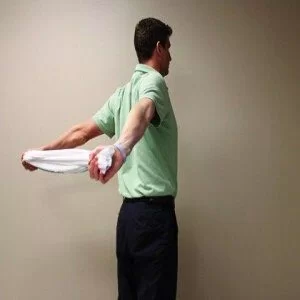
By extending the muscles in the chest and shoulders, the chest stretch is a basic Posture correction exercise that can assist in improving posture.
Raising your arms to shoulder height and pushing your shoulder blades together while maintaining your chest open is the goal of this exercise.
It’s an excellent workout for anyone who spends a lot of time sitting or slumped over a computer.
The step-by-step process to do chest stretch exercises is provided below:
- Initiate by standing tall with your feet shoulder-width apart.
- Straighten your arms, twist your fingers behind your back, or hold a towel.
- Squeeze your shoulder blades together as you raise your arms away from your body.
- Preserve your chest open & your shoulders relaxed.
- Maintain an open chest and relaxed shoulders.
- Return your arms to your sides after releasing the stretch.
- Repeating this exercise for 2-3 packs of 10-15 repeats, carrying a brief pause between each set.
- Precautions: Keep your shoulders relaxed throughout the stretch and avoid arching your back.
Glute Bridges
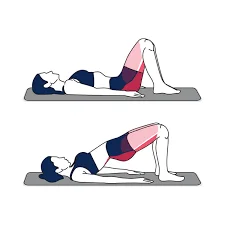
Glute Bridge assists in strengthening & activating your glutes while reducing lower back pain. This enhances the functioning and alignment of your hips and pelvis, showing a more suitable posture.
To do this exercise:
- Lie on your back with your knees bent and your feet about hip-distance separated.
- Hold your feet about a foot out from your hips.
- Relax your arms alongside your body with your palms fronting down.
- Exhale as you raise your hips toward the sky, straightening your spine.
- Keep this position for up to 1 minute at a period.
Plank

Plank Pose helps to improve posture by strengthening the muscles in the shoulders, back, core, glutes, and hamstrings. It even encourages correct alignment of the spine.
To do plank
- Get down onto your hands and knees. Check that your hands are aligned with your shoulders and your knees are aligned with your hips.
- Arrive onto the balls of the feet by lifting your heels and straightening your legs. The body should create a straightforward line.
- Hold your chest open and shoulders back.
- Keep this position for 30–60 seconds.
Hip Flexor Stretch
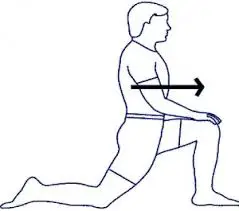
This stretch gently spreads the hips and improves balance and coordination, which can assist in enhancing posture.
To do a hip flexor stretch
- Kneel on the mate with your right knee.
- Put your left foot in front and flex your knee at a 90-degree angle.
- Hold your back straight, chest forward, & head erect.
- Put both hands on your left thigh.
- Push your hips forward and maintain the position for 20–30 seconds.
- Repeating this stretch on the other side.
Mountain Pose
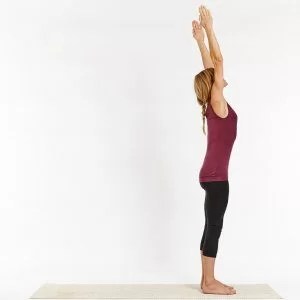
Tadasana, or Mountain Pose, is a simple yoga pose that can assist in enhancing posture. Mountain Pose concentrates on vertical body alignment, and it includes several aspects of right posture.
To do Mountain Pose
- Stand vertical with the feet hip-width separated.
- Make certain to distribute your weight equally through both feet. Try gradually swaying forward and backward to feel how deviations in weight distribution impact posture.
- Hold a small bend in your knees, press your thighs, and tilt your tailbone down.
- Drop your shoulders down and back, so your trunk comes ahead.
- Hold your shoulders loosened and permit your arms to fall to the sides of the body with your palms facing forward.
- Inhale and exhale gradually for a few breaths.
Child’s Pose

This yoga posture expands the hips and lengthens the lower back. People can use Child’s Pose as a resting position during yoga or other types of exercise or as part of their regular stretching routine.
To do Child’s Pose:
- Kneel on your hands and knees.
- Lean back gently, maintaining your hands in the same posture.
- Continue to lean back until your brow meets the floor.
- Your arms should be straight and your buttocks should be supported by your heels.
- Maintain straight arms and relaxed shoulders.
- This position may be made more comfortable by placing a mat or towel on the floor.
Cat-Caw Pose
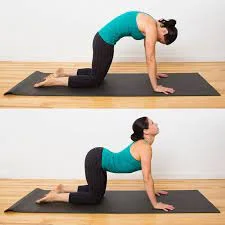
Cat-Cow posture relaxes your chest, shoulders, and neck while increasing blood circulation and spinal mobility.
To do this pose:
- Get on your hands and knees, balancing your weight equally over all four points.
- Inhale to gaze up, lowering your abdomen towards the ground and extending your spine.
- Exhale while arching your spine and tucking your chin into your chest.
- Maintain this motion for at least 1 minute.
Standing Cat Caw

This standing position, a variation on the standard Cat-Cow, helps to release the stiffness in your back, hips, and glutes.
To do this pose:
- You should have your feet hip-width apart and your knees slightly bent.
- Keep your hands in front of you or on your thighs.
- Round your spine, lengthen your neck, and bring your chin towards your chest.
- Then raise your head, elevate your chest, and twist your spine in the other direction.
- Each posture should be held for 5 breaths at a time.
- Continue like this for a few minutes.
High Plank
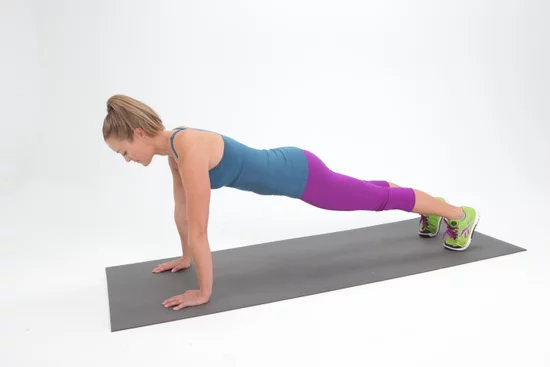
High planks help relieve pain and stiffness throughout your body while strengthening your shoulder glutes, and hamstrings. They also aid in the development of core and back strength, which is essential for proper posture.
To do this exercise:
- Straighten your legs, lift your heels, and raise your hips to all fours.
- Straighten your back and contract the muscles in your abdomen, arms, and legs.
- Lengthen your neck, soften your throat, and gaze down at the floor.
- Make sure your chest is open and your shoulders are back.
- Hold this position for one minute.
Side Plank
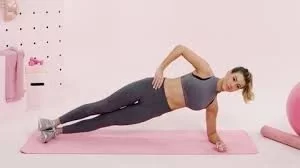
This exercise, a variant of the conventional plank, strengthens the muscles in your sides and glutes. Strengthening and aligning these muscles help support your back and improve posture.
To do this exercise:
- Bring your right hand into the center from a high plank posture.
- Stack your ankles and elevate your hips as you shift your weight to your right hand.
- Put your left hand on your hip or raise it to the ceiling.
- You can add extra support by lowering your right knee to the floor.
- Preserve this posture by engaging your abdominals, side body, & glutes.
- Look directly in front of you or up at your hand.
- Straighten your body from the crown of your head to your heels.
- For 30 seconds keep this pose & then rest.
- Repeat on the other side.
Down Ward Facing Dog
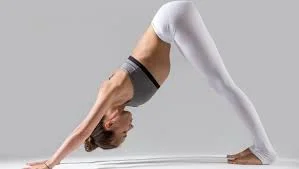
Down Ward Facing Dog is a forward bend that can be used as a resting pose to balance out the body. It can assist in relieving back pain, while also strengthening & aligning your back muscle.
To do this pose:
- Bring your right hand into the center from a high plank posture.
- Stack your ankles and elevate your hips as you shift your weight to your right hand.
- Put your left hand on your hip or raise it to the ceiling.
- You can add extra support by lowering your right knee to the floor.
- Hold this posture by engaging your abdominals, side body, & glutes.
- Straighten your body from the crown of your head to your heels.
- Look directly in front of you or up at your hand.
- For up to 30 seconds maintain this pose
- Repeat on the other side.
Pigeon Pose

This hip opening pose can also relax your spine, hamstrings, & glutes.
To do this pose:
- Get down on all fours, with your knees below your hips and your hands slightly in front of your shoulders.
- Bend your right knee and position it behind your right wrist, with your right foot arched out to the left.
- Place your right shin against the floor.
- Extend your left leg, straighten your knee, and place your thigh on the floor.
- Check that your left leg is straight back (not to the side).
- Lower your body slowly to rest on your inner right leg, arms outstretched in front of you.
- Maintain this posture for up to one minute.
- Slowly move your hands back towards your hips and elevate your torso to exit the posture.
- Repeat
Thoracic Spine Rotation
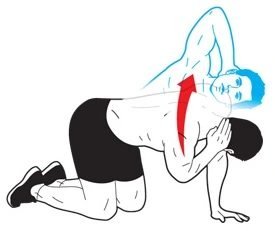
Gradually spread the chest and rotating the spine reduces while improving stability and mobility.
To do this stretch:
- Get on all fours and lower your hips to your heels, resting on your shins.
- Position your right hand behind your head, elbow stretched to the side.
- Maintain your left hand behind your shoulder or raise it to the center and rest it on your forearm.
- Exhale as you extend the front of your torso by rotating your right elbow up towards the sky.
- In this position, take a deep inhale and exhale.
- Return to your initial posture by releasing your grip.
- Repeat this movement 5-10 times on every side.
Isometric Pulls
Isometric pulls work your shoulder, arm, and back muscles, providing you the power to keep a good posture.
To do this exercise:
- Sit in a soft-backed chair.
- Make a fist with each hand and stretch your arms out in front of you, parallel to the floor.
- Exhale as you press your shoulder blades together and drag your elbows back towards your shoulders.
- Hold this posture for 10 seconds, breathing deeply.
- Gradually breathe out and return to the starting posture.
- Repeat this motion for one minute.
Wall Angels
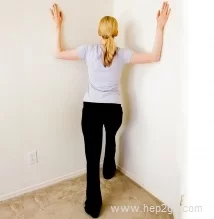
Wall angles are a straightforward and efficient exercise for improving posture and alleviating upper back discomfort.
This workout requires you to stand with your back to a wall and move your arms up and down in a “snow angel” manner. It’s an excellent workout for anyone who spends a lot of time sitting or hunching over a computer.
The step-by-step method to do chest stretch exercises
- Stand with your back to a flat wall, your feet about 6 inches apart, and your knees slightly bent.
- Raise your arms to shoulder height, elbows bent at a 90-degree angle and hands resting against the wall.
- Slowly raise and lower your arms in a “snow angel” motion, maintaining your hands and elbows in constant touch with the wall.
- Throughout the exercise, maintain your shoulders relaxed and your back flat on the wall.
- Repeat for a total of 2-3 sets of 10-15 repetitions.
- Precautions: Use moderate, controlled movements and maintain good form throughout the workout.
Seated Twist
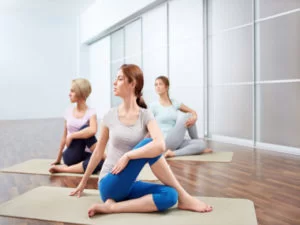
The sitting twist is a simple yet effective exercise for increasing spinal mobility and decreasing back and neck stress. It’s an excellent workout for anyone who spends a lot of time sitting or has back or hip discomfort.
To do seated twist exercise
- Sit on the ground, with cross legs in front of you.
- Place your left hand on your right knee and your right hand behind your right hip on the floor.
- Inhale and raise your head, stretching your spine.
- Exhale by twisting your torso to the right and lightly pushing on your right knee with your left hand to deepen the stretch.
- Hold for a few breaths before inhaling and returning to the center.
- Rep with your right hand on your left knee and your left hand on the floor behind your left hip on the other side.
- Alternate sides for another 2-3 sets of 10-15 repetitions.
- Precautions: Throughout the workout, maintain your spine tall and your breath steady, and don’t stretch too hard into the twist if it seems painful.
Tips for doing Posture correcting Exercises safely and effectively
- Warm up before you start exercising by doing some light cardio and dynamic stretches.
- Focus on proper form and technique.
- Don’t sacrifice form for speed or weight.
- Breathe deeply and evenly throughout your workouts.
- Listen to your body and quit if you experience any discomfort.
Benefits of doing Posture Correcting Exercises
- Reduced pain and stiffness in the neck, back, and shoulders
- Improved energy levels
- Increased flexibility and range of motion
- Reduced risk of injury
- Improved appearance and confidence
- Better balance and coordination
- Increased lung capacity
- Improved circulation
- Reduced stress levels
Posture-correcting exercises are an important part of a healthy lifestyle. By doing Posture-correcting exercises regularly, you can improve your overall posture and enjoy the many benefits that come with it.
FAQs
What is a Postural Correcting Exercise?
Postural correcting exercises are exercises that help to strengthen the muscles that support good posture and stretch the muscles that are often tight and shortened due to poor posture. These exercises can help to improve the alignment of your spine, reduce pain and stiffness, and increase your range of motion.
What is the cause of poor posture?
There are many different causes of poor posture, but some of the most common include, Muscle weakness or imbalance, Sedentary lifestyle, Poor ergonomics, Injuries, and Medical conditions.
How to maintain correct posture?
To maintain correct posture, it is important to be aware of your body’s alignment and to make adjustments as needed. Here are some tips:
Be mindful of your posture throughout the day, especially when you are sitting or standing for long periods of time, Take breaks to move around and stretch, Strengthen your core muscles, which help to support good posture, Avoid carrying heavy bags or backpacks on one shoulder, Use a supportive mattress and pillows when you sleep.
Can yoga help in correcting poor posture?
yes, yoga can help in correcting poor posture. Yoga poses stretch the muscles and joints, which can help to improve flexibility and range of motion. Yoga also strengthens the core muscles, which play an important role in maintaining good posture.
References
- Cronkleton, E. (2023, July 13). 12 exercises to improve your posture. Healthline. https://www.healthline.com/health/posture-exercises
- Eske, J. (2023, February 13). Exercises and tips for better posture. https://www.medicalnewstoday.com/articles/325883
- Hospitals, M., & Hospitals, M. (2023, June 22). 8 posture correction exercises you should try today. Manipal Hospitals. https://www.manipalhospitals.com/blog/8-best-posture-correction-exercises-you-should-try-today
- Turetsky, L. (2023, July 3). 10 Posture correction exercises – upper & lower back. Back Intelligence. https://backintelligence.com/exercises-to-improve-posture

